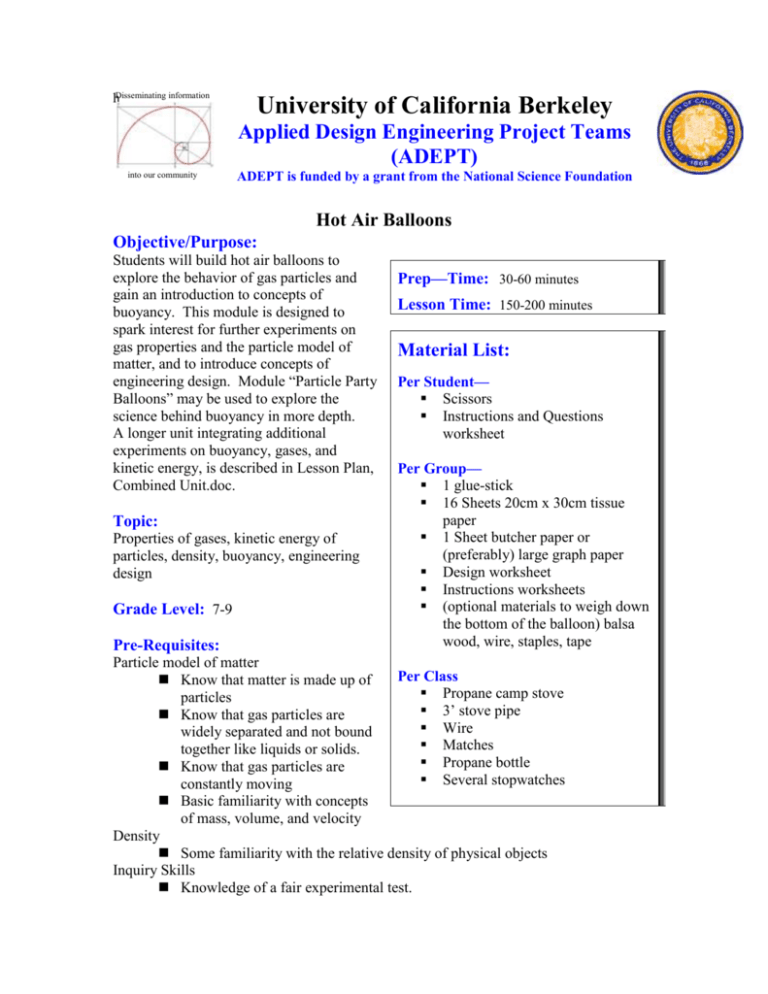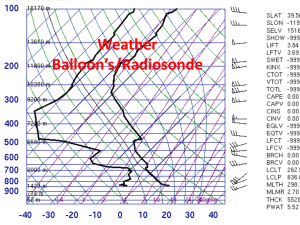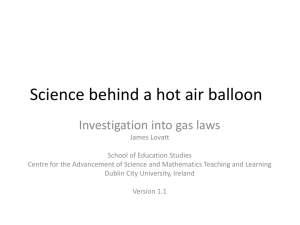doc
advertisement

hDisseminating information University of California Berkeley Applied Design Engineering Project Teams (ADEPT) into our community ADEPT is funded by a grant from the National Science Foundation Hot Air Balloons Objective/Purpose: Students will build hot air balloons to explore the behavior of gas particles and gain an introduction to concepts of buoyancy. This module is designed to spark interest for further experiments on gas properties and the particle model of matter, and to introduce concepts of engineering design. Module “Particle Party Balloons” may be used to explore the science behind buoyancy in more depth. A longer unit integrating additional experiments on buoyancy, gases, and kinetic energy, is described in Lesson Plan, Combined Unit.doc. Topic: Properties of gases, kinetic energy of particles, density, buoyancy, engineering design Grade Level: 7-9 Pre-Requisites: Prep—Time: 30-60 minutes Lesson Time: 150-200 minutes Material List: Per Student— Scissors Instructions and Questions worksheet Per Group— 1 glue-stick 16 Sheets 20cm x 30cm tissue paper 1 Sheet butcher paper or (preferably) large graph paper Design worksheet Instructions worksheets (optional materials to weigh down the bottom of the balloon) balsa wood, wire, staples, tape Particle model of matter Per Class Know that matter is made up of Propane camp stove particles 3’ stove pipe Know that gas particles are Wire widely separated and not bound Matches together like liquids or solids. Propane bottle Know that gas particles are Several stopwatches constantly moving Basic familiarity with concepts of mass, volume, and velocity Density Some familiarity with the relative density of physical objects Inquiry Skills Knowledge of a fair experimental test. Vocabulary: Lesson Process Summary: Preparation For The Lesson 1. Acquire materials, prepare large workspaces for gluing balloons. 2. Build a sample balloon, any design. Particle Kinetic Energy Density Mass Volume Engineering Design Process Prototype Conservation of Mass Initiating The Class 1. Demonstrate sample balloon. Light the camp stove, place the stove pipe on the grill over the flame, and fill the balloon through the stove-pipe 2. Suggestions for pre-assessment in a larger project on buoyancy, gases, and kinetic energy: a. Distribute pre-assessment tests b. Ask students to develop a theory for why the balloon flew, using the idea that all matter (including gases) are made up of particles. Have groups draw and write down their theory. 3. (Optional) Provide reading material on the composition of air, as a mixture of many gases. Procedures For Session Session 1: Prototyping 1. Separate class into groups of three students. 2. Provide balloon designs to students (HAB_Balloon_Templates.ppt) 3. Demonstrate the folding process for assembly the balloons, once they are cut out (see HAB_Balloon_Instructions.ppt for building instructions, also summarized in steps 4-10). 4. Provide template paper (large graph paper or butcher paper) CA Science and Math Standards: ID those standards met by this module http://www.cde.ca.gov/be/st/ss/index.asp Grade 8: Science Standards Structure of Matter 3.D Students know the states of matter (solid, liquid, gas) depend on molecular motion. 3.E Students know that in solids the atoms are closely locked in position and can only vibrate; in liquids the atoms and molecules are more loosely connected and can collide with and move past one another; and in gases the atoms and molecules are free to move independently, colliding frequently. Density and Buoyancy 8.A Students know density is mass per unit volume. 8.B Students know how to calculate the density of substances (regular and irregular solids and liquids) from measurements of mass and volume. 8.C Students know the buoyant force on an object in a fluid is an upward force equal to the weight of the fluid the object has displaced. 8.D Students know how to predict whether an object will float or sink. Investigation and Experimentation 9.A Plan and conduct a scientific investigation to test a hypothesis. 9.C Distinguish between variable and controlled parameters in a test. 5. Students use coordinates in balloon instructions to mark pattern on template paper. 6. Students cut templates out of butcher paper. 7. Provide 4 sheets of tissue paper & glue sticks to groups as they complete their templates. 8. Students should fold each sheet of tissue in half, stack the folded sheets, and use the template to cut out the panels of the balloons. 9. Students glue tissue paper. Panels should be glued one half at a time: spread glue onto the right edge of the panel. Lay the next panel on top, then fold over the unglued side of the new panel. Add glue to that edge, continuing to glue and fold until the last sheet (again, see HAB_Balloon_Instructions.ppt). 10. Students should gently spread open their balloons, repairing any holes with gluesticks and scraps of tissue paper. 11. Have students clean up work areas while balloons are drying time 12. Launch balloons Session 2: Design Review and Instruction 1. Distribute design worksheets, asking students to review what worked and what didn’t work with their balloon. 2. If combining with module “Particle Party Balloons,” which explores effects of volume and mass on whether something will float, perform that module and any bridge activities now, before redesigning balloons. See Lesson Plan, Combined Unit.doc and the Progress Guides for buoyancy and kinetic energy included with this module. These additional experiments will provide opportunities to explore why heating a gas causes volume and/or mass of the hot air balloon to change, based on the behavior of the gas particles, and what features of an object make it float (Small mass/Large Volume). 3. If done as a stand-alone module, discuss, to the depth deemed appropriate to the class: a. The fact that heating the air inside the balloon causes volume to expand, and mass to decrease, as air particles expand, pushing out the walls of the balloon and pushing some particles out of the balloon. b. For something to float, it needs to have a large volume and small mass, and that mass and volume can be combined in a measurement called density. 4. Ask students to start thinking about the following ideas: a. Should you use large volume or small volume? b. Should you use large mass or small mass? c. How can you keep the balloon stable? Session 3: Final Design 1. Pass out the Balloon Engineering Worksheets (HAB_Balloon_Engineering.doc) to students. 2. (Optional): Students read the science review related to hot air balloons. 3. Briefly introduce the simplified engineering design process: a. Identify Problem b. Brainstorming c. Analyze ideas d. Select an idea e. Refine design 4. Describe the idea of “trade-offs” in engineering. For the hot air balloons, two examples are: a. Increasing volume means increased mass of tissue paper, so can’t increase volume and decrease volume at the same time, and must make volume increase faster b. Adding weight to the bottom of the balloon can improve stability, but this also increases mass Other good examples are strength vs. weight in a bicycle, power vs. fuel efficiency in an automobile, and quality vs. cost for many products. 5. Instruct students to each generate 3 ideas for balloon shape or design, and then move through the design packet, as they are ready. 6. As groups, students identify at least one good thing and one bad thing for each design. 7. (Optional) Provide graph paper and show students how to estimate density by drawing their shape and comparing the number of boxes inside each shape to the perimeter of each shape. Students may have difficulty recognizing which shapes provide the most volume without a tool like this, but we found that this activity slowed down the design process more than we would have liked. 8. Groups pick their favorite balloon design, and explain why. 9. Provide tissue paper & glue sticks. Provide 12 sheets of tissue paper to each group, explaining that they may glue the regular sheets into larger sheets, to increase the volume of their balloon. 10. Students sketch new designs onto folded tissue paper 11. Students cut tissue paper as before 12. Students glue tissue paper as before 13. Clean-up materials 14. Drying time, while make pre-launch predictions 15. Launch! Reflection 1. Using knowledge about particles and density, students should think about a. what worked and what didn’t work in designing their balloon b. how they could improve the balloon. 2. Distribute post-test Example hot air balloon: Opened Flat









